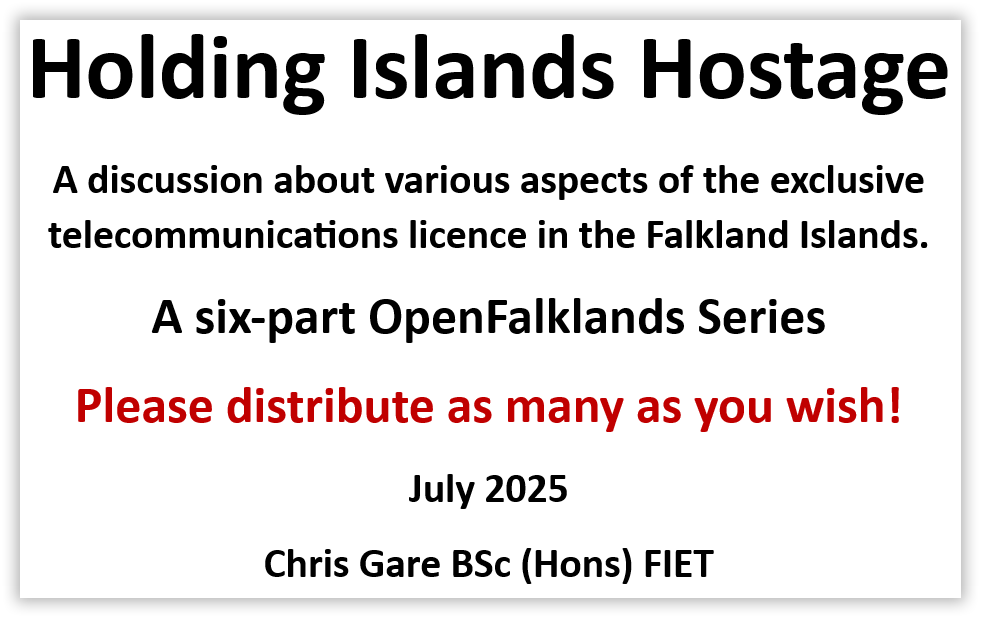To download a PDF copy of all the Holding Islands Hostage posts please click here.
This is the final post in the Holding Islands Hostage six-part series that has examined the current state of telecommunications in the Falkland Islands, highlighting a recurring pattern: ageing infrastructure, slow improvements, limited competition, and a single company, Sure South Atlantic and its subsidiary company, Sure Falkland Islands, continuing to dominate through exclusive licensing arrangements. Across the board, the result has been underwhelming service, high prices, and delayed innovation.
While Sure’s presence has historically been justified by geography and scale, the situation in 2025 is different. New technologies, particularly low-Earth orbit satellite services like Starlink, have shifted the balance. For the first time, remote regions have alternatives. And that means monopoly models must now be questioned seriously and urgently.
The expiration of Sure’s exclusive licence in December 2027 presents a rare opportunity to rethink how telecommunications are delivered in the Falklands. It opens the door to a more open, competitive, and accountable model. But that opportunity will only be realised if action begins now. Waiting until late 2026 or beyond to explore alternatives would repeat the mistakes of the past – delayed preparation, limited options, limited public input, and reactive policymaking.
The two core issues identified in this series remain unresolved:
-
There is still no clear explanation for the delay in launching promised services like Starlink or unlimited broadband for all.
-
There is growing concern that Sure is using future investment as a bargaining tool to secure continued exclusivity, rather than delivering improvements as part of its existing obligations.
At the same time, FIG and the Legislative Assembly are reviewing the options for what comes after 2027. Taken seriously, this could lead to a modernised regulatory framework based on a public/private arrangement; one that welcomes new entrants, separates universal service obligations (USOs) from monopoly licensing, and holds providers accountable for their performance, not just their promises.
The critical next steps are relatively clear:
-
Transparency – The stakeholders deserve access to accurate information on Sure’s performance, future plans, and financial claims.
-
Engagement – Islanders, businesses, and community groups must be part of the discussion on what kind of telecoms model will serve the Falklands best in the long term.
-
Regulatory Capacity – FIG must strengthen its ability to evaluate providers, enforce service standards, and manage a competitive licensing environment, including mechanisms to support USOs without relying solely on cross-subsidisation under a monopoly model.
-
Market Testing – Alternative providers should be actively encouraged to participate in the Falklands market. The Starlink licence is a promising first step, but other options should be explored to avoid dependence on a new single supplier.
-
A Clear Roadmap – A timeline should be published outlining how FIG intends to transition away from exclusive licensing, including criteria for future service delivery, funding mechanisms for Camp connectivity, Stanley fibre upgrades, and how competition will be introduced or managed.
The goal is not to punish any specific company. It is to ensure that all residents of the Falklands, whether in Stanley or in Camp, have access to affordable, reliable, and modern digital services. That cannot happen without systemic change. And it will not happen without political will.
This is a turning point. The next two years will determine whether the Falklands step into a future of competitive, resilient telecommunications or remain locked into a structure that has already shown its limits. This is no longer a question of technology or feasibility. It is a question of governance and priorities.
Failure to show a thought-out vision by the Legislative Assembly and FIG risks locking the Falklands into another decade (or 12 years) of digital underperformance. Islanders may continue to pay more for less, businesses will face barriers to growth, and opportunities in education, healthcare, and remote work will remain out of reach, particularly outside Stanley in Camp. With the Starlink decision, the first step has been taken.
 |
The situation has changed markedly. The success of the Starlink Petition Group and its petition has shown that grassroots action and democratic engagement can lead to meaningful change. May that momentum continue!

Chris Gare, OpenFalklands, July 2025, copyright OpenFalklands



In my view competition within the market will always be limited in the Falkland Islands, given the small scale of the market and lack of a terrestrial fibre drop-off. The Falkland Islands will probably find it optimal to have a single entity manage service delivery of satellite services (as is the case today). But the future model need not be one that perpetuates the legacy of the past. As I argued in a reply to your last post, I would strongly argue for a community gateway model with an exclusive on island infrastructure manager, subject to regulatory oversight. The local infrastructure manager should contract with Starlink (or other suitable provider) and invest in a modern local distribution network that accelerates services to best in class, given the circumstances. In the interim, users should be permitted to use VSAT to contract directly with Starlink. Once a community gateway is up and running and offering customers a service that is at least as good as that directly available and on financial terms no worse, users should be required to connect to the community gateway. The real competition lies in space: Intelsat v. Starlink (and other LEOs). On island, competition will be muted. There is the potential for a bright future, and one in which an infrastructure manager on the islands can help deliver state-of-the-art satellite services.